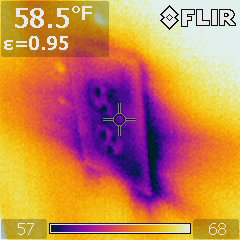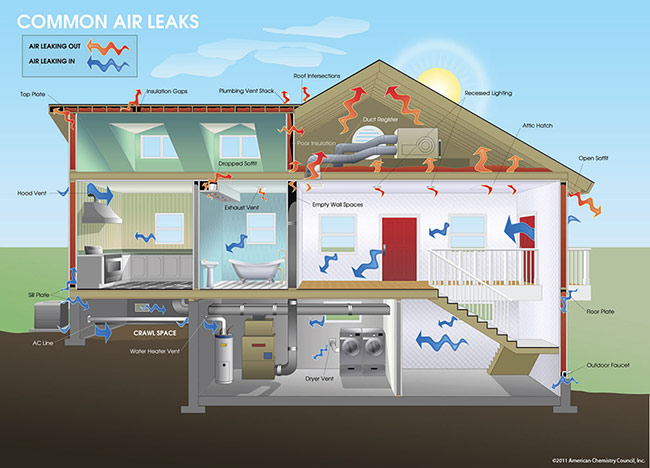Air leaking into your attic could be costing you money—up to 20% of a home’s heating and cooling energy is lost due to air leaks. You probably think of your ceilings as solid surfaces, but the truth is that ceilings leak air into unfinished attic spaces through gaps and openings, such as around pipes and lighting fixtures. That’s an annual $400 bite out of your wallet that you can prevent. Therefore, fixing air leaks is on par with insulating an attic as must-do attic tasks.

Find air leaks
From below your attic, check the ceilings and note the locations of all light fixtures, ceiling fans, and electrical outlets. From the attic-side of your ceiling, find the fixtures you noted. You’ll have to pull back existing insulation to find them.
Electrical connections for fixtures, fans, and outlets require a hole cutout in your ceiling drywall. Each of these cutouts is a likely air leak. You can stop air leaks by sealing the cutouts from above with acrylic latex or silicone caulk, or with low-expansion polyurethane foam, depending on the size of the gap.
Also check for anything that penetrates the ceiling:
- pipes
- vent stacks
- flues and chimneys
- electrical wiring
- heating and air conditioning ducts
- access hatch
Gaps around these locations should also be sealed from above.
Plug large gaps
Low-expansion polyurethane foam in a can is great for plugging openings 1/4-inch to 3 inches wide, such as those around plumbing pipes and vents. The plastic straw applicator seals shut within two hours of the first use, so to get the most mileage out of a can, squirt a lubricant such as WD-40 onto a pipe cleaner and stuff that into the applicator tube between uses.
Plug small gaps
Caulk makes the best gap-filler for openings less than 1/4-inch wide, such as those cut around electrical boxes. Fire Caulk costs the most but works better next to nonporous materials, such as metal flashing, or where there are temperature extremes, as in attics.
Seal air leaks around flues and chimneys
Building codes require that wood framing be kept at least one inch from metal flues and two inches from brick chimneys. But that creates gaps where air can flow through. Cover the gaps with aluminum flashing cut to fit and sealed into place with high-temperature fire block caulk .
To keep insulation away from a hot flue pipe, form a barrier by wrapping a cylinder of flashing around the flue, leaving a one-inch space in between. To maintain the spacing, cut and bend a series of inch-deep tabs in the cylinder’s top and bottom edges.
Weatherstrip the attic access hatch
A quarter-inch gap around pull-down attic stairs or an attic hatch leaks the same amount of air as a bedroom heating duct. Seal it by caulking between the hatch frame and the rough opening, or by installing foam weatherstripping around the perimeter of the hatch opening. Or, you can buy a pre-insulated Attic Tent insulated stair cover.
Thermal Camera Energy Audits

Professional insulation companies offer Thermal Camera Energy Audits. Some companies charge for this service, most of your more professional companies offer this service for free in an effort to earn your business. Thermal cameras find even the smallest air leaks and some water leaks too.
For more information on hpw to make your home more energy efficient call Aladdin Insulation and Home Improvements 678-528-7115 or visit us at aladdinhomepros.com
